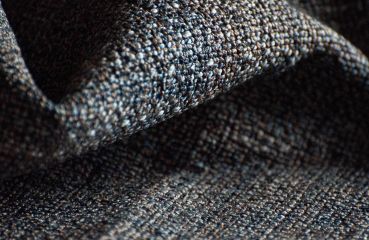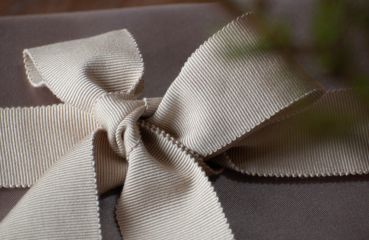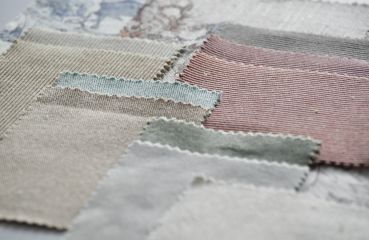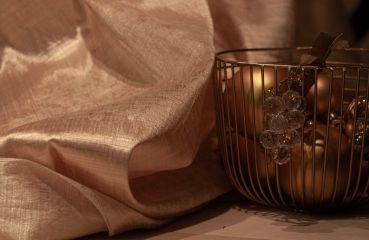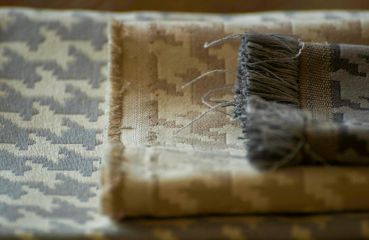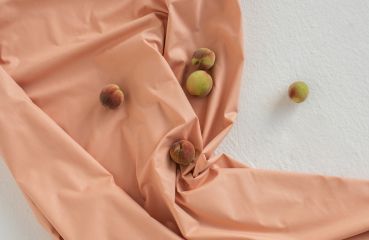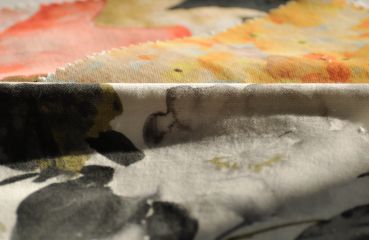ABOUT TABLE TOP FABRICS
What does it mean to be "put at the grey end"

PARADISSO Dahlia
It is believed that a highly decorative, colourful and extravagant table setting demonstrates the artistic and flamboyant nature of the host, whereas a pure white cotton tablecloth is the reflection of impeccable manners and good upbringing.
A white tablecloth, similarly to a white shirt, is a synonym of elegance and highlights the status and importance of a place or situation. In history and culture, white tablecloths used to be part and parcel of aristocratic life.
The history of the tablecloth is almost as long as the tradition of sharing a table. A piece of cloth was always a more welcome sight than a rough surface of a table. Over time, as the latter became a more sophisticated piece of furniture, tablecloths served an additional function of protecting table tops against soiling.
The standards defined in Europe at the beginning of the 18th century applied for almost 200 years that followed. As was the case with fine china, the only acceptable colour of tablecloths was pure white – this changed as late as the interwar period.
The use of tablecloths as we know it today developed together with the fashion for uniform porcelain sets. The idea was to standardise tableware so that it no longer denoted the status of the banqueters. Before that, the king, or the most prominent person at the table, used the most ornate plates and cutlery, other guests – less decorative tableware, while those seated furthest away from the monarch or the host had to do with decidedly inferior dishware. The same applied to tablecloths, hence the Polish saying "to be put at the grey end", which is a reference to the least important place at the table, where plain grey cloth was used instead of delicate white embroidered napery.

CANVA Dove
Being eco-conscious and eager to use cloth or linen tablecloths, we find this story hard to believe. Today, it is also very difficult to follow all the tenets of savoir-vivre which required that the tablecloth at home should always be carefully ironed, without any trace of folding. Interestingly, folding lines were highly desirable at restaurants as they signified that the tablecloth had just been changed by the waiter. It is no wonder that until recently there was an unwritten classification of restaurants in which the prices in the menu were also influenced by whether white tablecloths and napkins were used or not.

PEGGY, CANVA
It seems that the times of strict rules applying to table linen at our homes and in restaurants are now inevitably gone. For many years we have been enjoying an unlimited freedom in selecting fabrics and patterns. Similar changes occurred in the kitchen, which opened its doors to the world, different cultural influences and exoticism, drifting towards new and unexplored territories.
Today, in the age of slow life and slow food, every meal is an event in its own right. Setting the table is a ceremony featuring fabrics as important elements of scenography, which just like tableware, decorations and even food may determine the character of the entire meal.

PARADISSO Dahlia

PARADISSO Dahlia

PARADISSO Dahlia
No wonder that the tablecloth is now considered a “label” of the table. It is after all its attire and similarly to the clothes we wear nowadays it may be extravagant, revealing, downright crazy or... essentially ordinary. Fabrics on the table say a lot about our taste and sense of style. The devil is always in the detail: weave, printed pattern, colour shade, drapability – the key is to select a "label" which has its own distinctive character, attracts attention and decorates the table in a way that most accurately reflects the culinary and social situation.

DEMETER Blue

DEMETER Blue
The wishing-table – vade mecum of table top fabrics.

HEDONE Rosa and Blue
"The first and most important rule of setting the table is that the napery must be spotless and as white as snow. Both colour and white tablecloths and napkins used during breakfasts and tea parties must be soft, shiny and very carefully ironed on both sides. Moderation is vital when starching to preserve the freshness of fabrics. A stiff napkin is unpleasant to the touch, drapes poorly and falls far short of refinement" [excerpt from an interwar brochure "On parties and the dining table"].
As mentioned earlier, the times of stringent rules are long gone. Yet, some principles of using fabrics as table linen still apply and make our lives easier.
The best results in creating decoration, evoking the right mood and setting the background for food presentation are achieved by carefully harmonising three elements: colour, pattern and tactile properties of the fabric.
It seems that the most predominant element is the colour. However, the choice goes beyond the traditional rule stating that white tablecloths are used during formal luncheons and dinners, and colourful tablecloths should be reserved for breakfasts and afternoon tea parties. As we know, colours can strongly influence our mood and, as it turns out, our appetite. Thus, selecting the right colour is profoundly important. For example, even though they are considered energetic, stimulating and appetising, shades of yellow and orange can also be found excessively aggressive and dazzling. If you need a background for colourful tableware and food, it is better to use fair, soft shades as well as melange weaves accentuated in the light.

PEGGY
The same goes for patterns. A combination of strong colours and patterns on the tablecloth will not work for everybody. Given that we often look at table linen from above, we must make sure that the composition goes together with the tableware used. A rich combination of multiple colours may help you avoid monotony and increase the appeal of your table but it requires a good sense of style and composition skills. If you want to avoid a tiring, cluttered effect, it is better to use muted graphic or water colour patterns that are more sublime and free of strong contrasts.
Another key aspect of choosing a fabric for your table is its drapability – you need a flowing fabric that is easy to arrange and takes the shape of the furniture it covers.

from left: HELLE Natural, PURO Dove, PURO Primrose

PURO Dove
As for the utility of table top fabrics, their quality is of the essence. The best fabrics for this purpose are linen and cotton – they are durable and easy to maintain. Also, fabrics with a modern sustainable raw material composition including acrylic and synthetic blends may be used to an equally good effect.
Modern cotton is soft, flexible, flowing and delicate. It does not wrinkle and nicely drapes the table, which makes it a perfect choice for everyday use and for special occasions alike. It is also long-lasting and very durable. On the downside, removing stains from cotton is not an easy task, especially when it comes to grease or wine stains. Therefore, the fibre is often blended with synthetics, which improve its maintenance properties. Importantly, cotton should always be ironed on its back side to preserve the colours or printed patterns.
One of the greatest aspects of linen is its elegant appearance. Additionally, it can withstand long years of use, does not cling and retains its original size due to high shrinkage resistance. What is more, stains can be easily removed from linen, especially if the fabric has been starched beforehand. More and more often we use modern linen fabrics with the washed effect, which cannot be ironed perfectly smooth and whose aesthetics are based on their natural softness.

HEDONE Rose and Blue
In addition to their elegant appearance, cotton and linen fabrics are safe for our health, they absorb humidity, are breathable and may even help maintain a healthy skin balance. They have a perfect, durable, wear-resistant texture.
Tablecloths are not the only way you can use fabrics on your table. To emphasise the beauty of the table top, you simply need to put a small piece of fabric next to or under your dishware as a placemat.
Another important element of a properly set table are napkins. According to traditional rules they should be "white or colourful, 50x50 cm, 40x40 cm folded three times or 30x30 cm folded two times".
Naturally, today you can use napkins of any size you like, starched and folded or exactly the opposite – left in their natural condition, sometimes even unhemmed. Just like trusty butlers, napkins serve various functions: they line bread baskets or fruit plates, coat and protect wine bottles, hold your cutlery and cover the lids of jars with preserves.oothe the skin”?


on top PARADISSO Dream, underneath HEDONE Rose
Decorative pieces of fabric on the table may additionally be tied with an embellishing fabric strip. There is something mystical to untying or unfolding them, as it highlights the importance of the moment but also gives you time to touch and feel the fabric.

CANVA
Ever since we started enjoying and celebrating meals outdoors, sometimes in some unusual scenery, the use of decorative fabrics has been extended to include more than just traditional tables.

PERSEFONA Meadow

HYBRIS Blue

HYBRIS Blue
A soft piece of fabric (cotton, linen, polyester-cotton or polyester-linen, jacquard or printed) taken to the beach, meadow or forest will enable you to transform an everyday meal into an amazing festival of good taste. That is as long as the fabric is easy to clean, unpretentious, blends well into the surroundings and provides a sense refinement regardless of the circumstances.
The moment of enjoying a meal makes everyday life transcend like the eternity. Every day you can create a masterpiece. Fabric is a versatile and easily available material which will help you create the right mood for every occasion. Let it run freely. Let it make your daily life more exquisite, beautiful... simply better.

HEDONE Blue
All fabrics presented in this article are part of the DEKOMA Summer 2019 collection:
Double width linen fabric with a beautiful floral background pattern. Digital print in two colours: pink and sky blue. Its special finish makes the fabric very soft to the touch.
Double width linen fabric in pastel shades of pink and sky blue. Hedone is plain coordinate for the patterned Hybris. Its special finish makes the fabric very soft to the touch and more wrinkle-resistant.
Linen fabric with a natural slightly worn appearance. Persefona is printed with a floral pattern comprising thistle flowers. Requires decatising before use.
Double width cotton fabric with an abstract floral pattern on a white background. It has a characteristic, very smooth and soft surface.
This 3 metre high polyester decorative fabric is available in 32 colours. Its fine mesh structure and considerably high grammage enhance the fabric’s drapability.
Double width linen-viscose fabric with a beautiful floral pattern inspired by old drawings. It has a large repeat with meticulous details. Blended with viscose and linen, it is pleasant to the touch.
Double width polyester-linen blend. Digitally printed with a floral pattern of intertwining flower motifs with a large repeat, inspired by impressionist paintings.
TABLE TOP PHOTOSHOOT
Photography: Przemek Kulikowski
Styling: Anna Marciniak
REMAINING PHOTOS FROM THE LONG BEACH NY SESSION
Photography: Boris MIller
Styling: MBBM Studio







